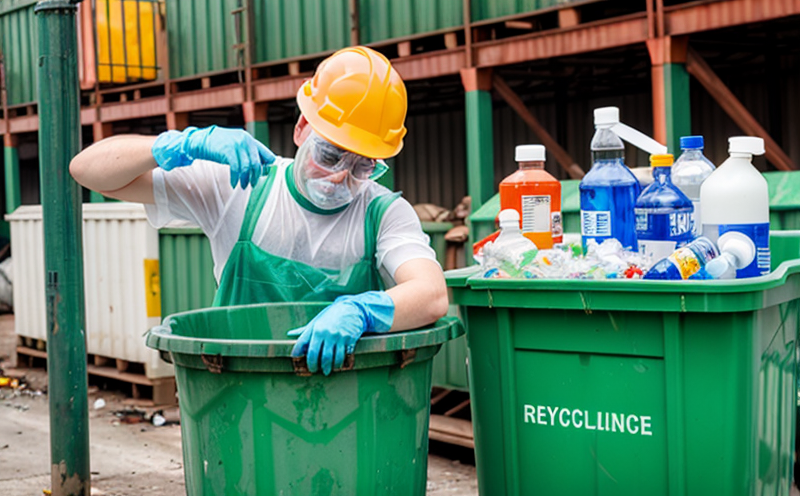ASTM D6319 Hazardous Chemical Testing in Waste Rubber
The ASTM D6319 test method is a critical procedure for identifying and quantifying hazardous chemicals present in waste rubber materials. This service plays an essential role in ensuring that waste rubber products comply with environmental regulations and health standards.
Waste rubber encompasses a broad range of materials, including scrap tires, conveyor belts, hoses, and various industrial rubber components. These materials often contain residual chemicals from their manufacturing processes or aging degradation products, making them hazardous if not properly managed. The ASTM D6319 test method is designed to detect the presence of these potentially harmful substances in waste rubber.
The testing procedure involves a series of steps aimed at extracting and identifying chemical compounds that could pose risks during waste management and recycling processes. Specimen preparation for this test includes thorough sampling, homogenization, and appropriate dilution or concentration adjustments as necessary. The chosen extraction solvents must be compatible with the target analytes to ensure accurate detection.
The analytical methods used in ASTM D6319 typically involve instrumental analysis techniques such as gas chromatography-mass spectrometry (GC-MS) and liquid chromatography-tandem mass spectrometry (LC-MS/MS). These advanced technologies provide high sensitivity and selectivity, enabling the identification of even trace amounts of hazardous chemicals. The test results are reported in standardized units, often parts per million or micrograms per gram, depending on the chemical compound being analyzed.
The ASTM D6319 method is particularly useful for regulatory compliance purposes. It helps waste management companies and recycling facilities ensure that their operations comply with environmental laws like the Resource Conservation and Recovery Act (RCRA) in the United States. By identifying hazardous chemicals in waste rubber, this test aids in proper classification of waste materials, thereby facilitating appropriate disposal methods.
For R&D engineers involved in developing new recycling processes or innovative waste management strategies, ASTM D6319 offers valuable insights into the chemical composition of waste rubber. This information can be used to optimize recycling techniques and minimize environmental impacts. Compliance officers can rely on this test method to verify that their facilities are meeting regulatory requirements and avoiding non-compliant waste streams.
Quality managers responsible for maintaining high standards in production processes will benefit from ASTM D6319 by gaining a better understanding of the chemical residues left behind after rubber products reach the end of their lifecycle. This knowledge can inform decisions about how to handle these materials responsibly, potentially reducing costs associated with improper disposal.
ASTM D6319 ensures that waste rubber is managed safely and sustainably. By identifying hazardous chemicals early in the recycling process, this test helps prevent contamination of other recyclable materials and reduces risks associated with exposure to harmful substances during processing or end use applications.
Benefits
The benefits of ASTM D6319 Hazardous Chemical Testing in Waste Rubber extend beyond mere compliance; they encompass environmental stewardship, operational efficiency, and risk management. Here’s a closer look at these advantages:
- Environmental Compliance: Ensures that waste rubber meets stringent regulatory standards for hazardous substances.
- Eco-friendly Recycling: Promotes responsible recycling practices by identifying harmful chemicals early in the process.
- Risk Reduction: Minimizes risks associated with exposure to hazardous chemicals during processing and end-use applications.
- Informed Decision Making: Provides data-driven insights that help quality managers optimize production processes and reduce operational costs.
By leveraging ASTM D6319, organizations can demonstrate their commitment to sustainability while adhering to legal requirements. This not only enhances reputation but also contributes positively to public health and environmental protection.
Industry Applications
- Tire Recycling: Identifies residual chemicals in scrap tires for proper disposal methods.
- Rubber Conveyor Belt Management: Assesses the chemical composition of used conveyor belts to ensure safe recycling.
- Industrial Rubber Component Disposal: Evaluates waste from industrial rubber components like hoses and seals.
- Pipeline Insulation Maintenance: Monitors discarded pipeline insulation for hazardous chemicals before reuse or disposal.
The ASTM D6319 test method is applicable across various sectors, including automotive manufacturing, construction, and infrastructure maintenance. It supports industries committed to sustainable practices by providing essential information on the chemical composition of waste rubber materials.
International Acceptance and Recognition
The ASTM D6319 test method is widely recognized and accepted in numerous countries around the world, reflecting its importance in global waste management standards. Here are some key points regarding international recognition:
- Australia: Compliance with Australian environmental regulations for rubber waste disposal.
- Canada: Adherence to Canadian hazardous waste management guidelines.
- European Union: Integration into European Union directives on waste recycling and management.
- United Kingdom: Alignment with UK environmental protection acts.
The ASTM D6319 method is referenced in several international standards, including ISO 14001 for Environmental Management Systems. Its adoption by countries like China and India further underscores its global relevance. This widespread acceptance ensures that the test results are universally valid and comparable across different jurisdictions.





